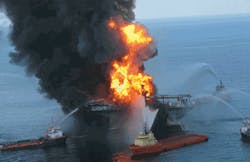In 1970, President Richard Nixon helped establish OSHA. As a result, worker safety became a federal responsibility, with regional and area offices established throughout the United States to enforce OSHA standards.
While the intention of creating OSHA was noble, there's a perception among some stakeholders that the fines and penalties at the agency's disposal provide minimal incentive for employers to comply with OSHA regulations. By contrast, EPA – another Nixon creation – has been empowered to impose herculean sanctions, fines and penalties on employers and facilities for violation of environmental laws and regulations.
For example, the maximum penalty that OSHA can impose for a single willful violation is $70,000. EPA, on the other hand, can fine up to $250,000 per day, per violation. EPA also can impose criminal sanctions, working hand-in-hand with the Department of Justice. The fine and penalty provisions for EPA virtually are limitless.
That's not the case when we discuss OSHA. For instance, OSHA only is able to pursue a criminal penalty when a willful violation of an OSHA standard results in the death of a worker. The maximum penalty is a misdemeanor with a maximum of six months in jail.
In 2006, as an interim measure to strengthen the agency's enforcement capability, OSHA, EPA and the Department of Justice announced a joint compact called the Worker Endangerment Initiative. Since then, the three agencies have pursued several high-profile criminal prosecutions.
According to the Justice Department's website:
"The Worker Endangerment Initiative arises out of the principle that employers who are willing to ignore worker-safety laws in their efforts to maximize production and cut costs will ignore environmental laws as well. Accordingly, the Environmental Crimes Section and the Environmental Protection Agency Criminal Investigation Division provided [OSHA] compliance officers with criminal investigative and environmental training so that serious environmental crimes may be identified. [More than] 1,000 OSHA inspectors, managers and Department of Labor Solicitors have received training."
In the initiative's pilot case, the agencies pursued criminal charges against several managers at the Atlantic States Cast Iron Pipe Co. for environmental crimes and worker-safety violations.
Not every OSHA violation qualifies as an EPA violation. Nevertheless, OSHA inspectors have been trained to look for environmental violations during facility inspections.
Under federal law, both EPA and OSHA regulate companies' hazardous-chemical management programs. In many respects, EPA's requirements for risk-management plans and OSHA's requirements for process-safety management are the same regulations. Consequently, when a company or facility is in violation of one standard, it likely is in violation of the other as well.
Some of the more prominent enforcement actions under the Worker Endangerment Initiative are highlighted below.
Hershey Co.
In November 2008, the Hershey Co. pleaded guilty to violating the Clean Air Act and agreed to pay a $100,000 fine, for failing to develop and implement a risk-management plan at two of its facilities in Pennsylvania.
Triggered by an OSHA inspection, the case was referred to the Justice Department for criminal enforcement even though there was no chemical-release incident that prompted the action.
At the time of Hershey's guilty plea, EPA noted that the company stored large amounts of anhydrous ammonia at its plants in Harrisburg and Middletown, Pa., for use in its refrigeration systems.
"Anhydrous ammonia is regulated under the [Clean Air Act] because it is flammable and can irritate both the skin and eyes," EPA said in a 2008 news release. "The CAA regulations required Hershey to develop and implement a risk-management program for each facility to, among other things, protect worker safety, minimize the chance of a release from refrigeration processes at the facilities that would endanger workers and surrounding communities, and to develop and implement prevention and emergency response plans."
The case was the first prosecution of a company for failing to have a proper risk-management plan under the Clean Air Act.
Tyson Foods
In January 2009, Tyson Foods Inc. pleaded guilty in a federal court to a willful OSHA violation that led to an employee's death at the company's River Valley Animal Foods plant in Texarkana, Ark. The court ordered Tyson Foods to pay $500,000 – the maximum criminal fine – and serve one year of probation.
The prosecution and plea agreement stemmed from a 2003 incident in which Tyson maintenance worker Jason Kelley was overcome by hydrogen sulfide gas (a byproduct of the rendering of chicken feathers) while repairing a leaking hydrolyzer. Kelley later died, and another employee and two emergency responders were hospitalized due to exposure during the rescue attempt, according to court documents.
Despite the fact that the incident was investigated by OSHA and treated as a violation of OSHA standards, the Justice Department's Environmental Crimes Section took the lead in the prosecution to augment the punishment and penalties against Tyson.
The fatality was a repeat violation involving the same facility and rendering processes that resulted in the death of an employee one year earlier. The aggravating circumstances arguably justified the coordinated enforcement under the Worker Endangerment Initiative.
Beef Products
In April 2013, Beef Products Inc. agreed to pay a $450,000 civil penalty for alleged violations of the Clean Air Act at the company's meat-processing facility in Waterloo, Iowa.
The settlement stemmed from a 2007 incident at the now-closed Waterloo facility in which more than 1,000 pounds of anhydrous ammonia were released into a production area. Exposure to anhydrous ammonia left one worker permanently disabled and another worker dead. During the response to the release, management directed its employees to enter the facility while dangerous levels of airborne anhydrous ammonia remained present, according to EPA.
After the 2007 incident, EPA gathered information about the release and facility operations through information requests and an inspection. The agency determined that Beef Products had a risk-management program on paper, but failed to implement the program at the Waterloo facility, contributing to the 2007 incident.
"The implementation of a risk-management program is integral to the safe operation of facilities where anhydrous ammonia is used," EPA regional administrator Karl Brooks said. "The 2007 incident in Waterloo demonstrates that having a plan only on paper increases the risk of accidental exposure to both employees and first responders."
OSHA got the ball rolling by citing Beef Products for various safety violations concerning the ammonia release and fatality that included process-safety-management violations, and later referred the case to EPA. The case became a coordinated enforcement action leveraging the Worker Endangerment Initiative.
BP
On April 20, 2010, a gas release and subsequent explosion on the Deepwater Horizon oil rig killed 11 workers and injured many others. Oil continued to flow into the Gulf of Mexico for several months after the accident, making it the largest oil spill in U.S. history.
Commensurate with the scale of the disaster, BP PLC and rig operator Transocean Deepwater Inc. have agreed to pay gargantuan civil and criminal fines, as OSHA, EPA and DOJ have prosecuted the companies through the Worker Endangerment Initiative.
In November 2012, BP agreed to plead guilty to felony manslaughter, environmental crimes and obstruction of Congress and pay a record $4 billion in criminal fines and penalties for its actions that led to the Deepwater Horizon disaster.
Conclusion
In grade school, we're taught that the U.S. Constitution prohibits someone from being tried for the same offense twice. This is known as the prohibition against "double jeopardy" and has been the subject of movies and novels throughout our nation's history. However, in the arena of federal enforcement, double jeopardy is a reality.
Violations of federal law can result in both civil and criminal penalties. Environmental crimes and OSHA violations can cross agency lines and result in multi-agency enforcement.
While Congress hesitates to strengthen OSHA's enforcement capability, the federal bureaucracies have created their own remedy to fill the void. Manufacturers that use hazardous chemicals need to be aware that violations of OSHA PSM regulations can be referred to EPA for RMP review and consideration of further enforcement.
When the Justice Department brings its mighty enforcement muscle to bear, it creates a triple-jeopardy threat that most companies and individuals can ill-afford to fight.
Bruce Smith is a Nebraska licensed attorney who specializes in environmental, health and safety law. He works at the Goosmann Law Office in Sioux City, Iowa.

